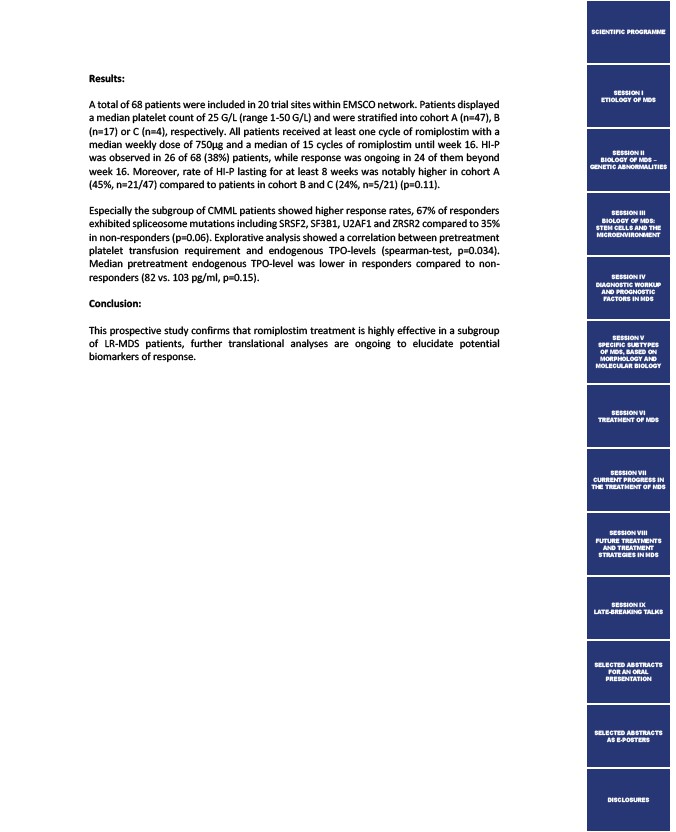
Results:
A total of 68 patients were included in 20 trial sites within EMSCO network. Patients displayed
a median platelet count of 25 G/L (range 1-50 G/L) and were stratified into cohort A (n=47), B
(n=17) or C (n=4), respectively. All patients received at least one cycle of romiplostim with a
median weekly dose of 750μg and a median of 15 cycles of romiplostim until week 16. HI-P
was observed in 26 of 68 (38%) patients, while response was ongoing in 24 of them beyond
week 16. Moreover, rate of HI-P lasting for at least 8 weeks was notably higher in cohort A
(45%, n=21/47) compared to patients in cohort B and C (24%, n=5/21) (p=0.11).
Especially the subgroup of CMML patients showed higher response rates, 67% of responders
exhibited spliceosome mutations including SRSF2, SF3B1, U2AF1 and ZRSR2 compared to 35%
in non-responders (p=0.06). Explorative analysis showed a correlation between pretreatment
platelet transfusion requirement and endogenous TPO-levels (spearman-test, p=0.034).
Median pretreatment endogenous TPO-level was lower in responders compared to non-responders
(82 vs. 103 pg/ml, p=0.15).
Conclusion:
This prospective study confirms that romiplostim treatment is highly effective in a subgroup
of LR-MDS patients, further translational analyses are ongoing to elucidate potential
biomarkers of response.
SCIENTIFIC PROGRAMME
SESSION I
ETIOLOGY OF MDS
SESSION II
BIOLOGY OF MDS –
GENETIC ABNORMALITIES
SESSION III
BIOLOGY OF MDS:
STEM CELLS AND THE
MICROENVIRONMENT
SESSION IV
DIAGNOSTIC WORKUP
AND PROGNOSTIC
FACTORS IN MDS
SESSION V
SPECIFIC SUBTYPES
OF MDS, BASED ON
MORPHOLOGY AND
MOLECULAR BIOLOGY
SESSION VI
TREATMENT OF MDS
SESSION VII
CURRENT PROGRESS IN
THE TREATMENT OF MDS
SESSION VIII
FUTURE TREATMENTS
AND TREATMENT
STRATEGIES IN MDS
SESSION IX
LATE-BREAKING TALKS
SELECTED ABSTRACTS
FOR AN ORAL
PRESENTATION
SELECTED ABSTRACTS
AS E-POSTERS
DISCLOSURES